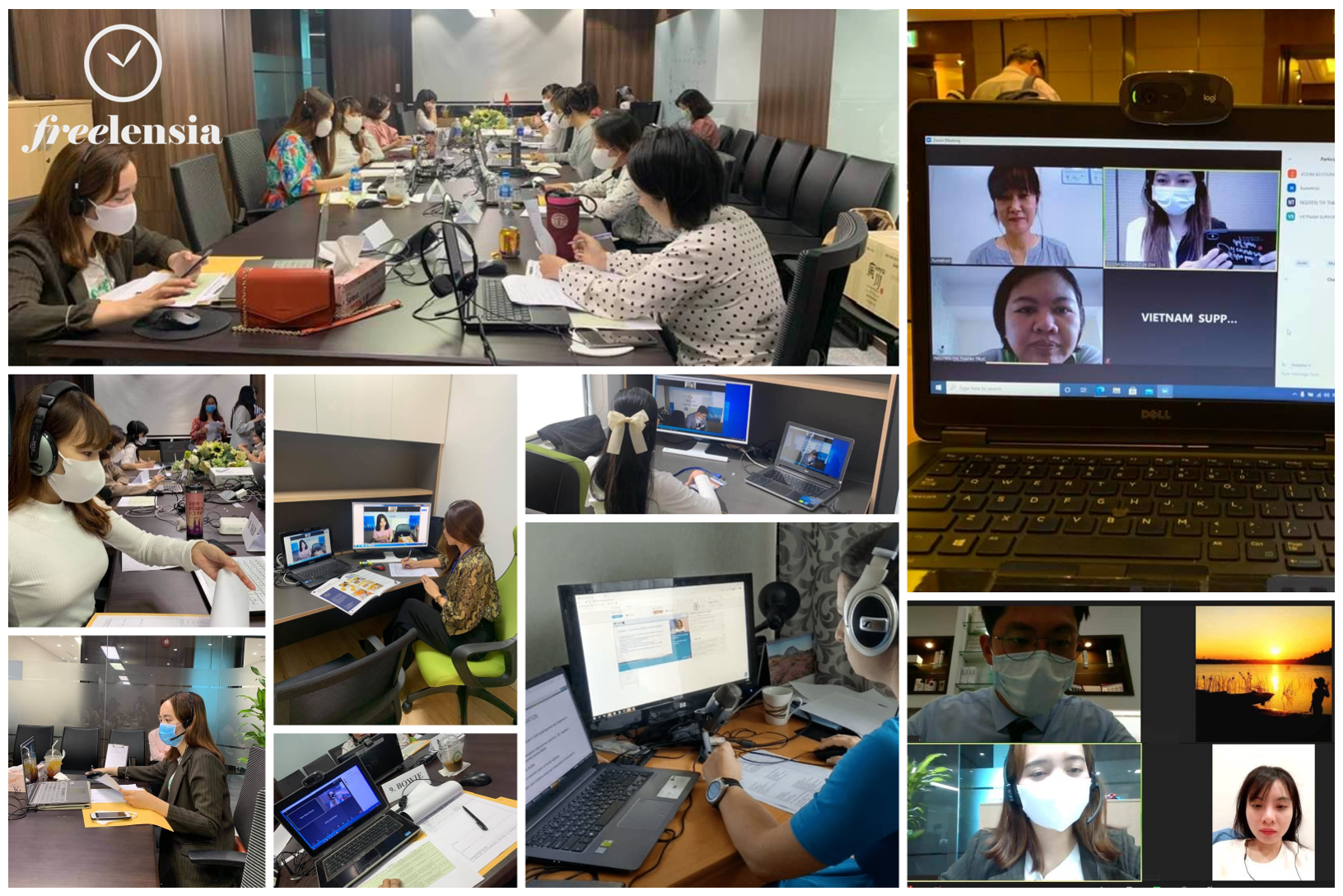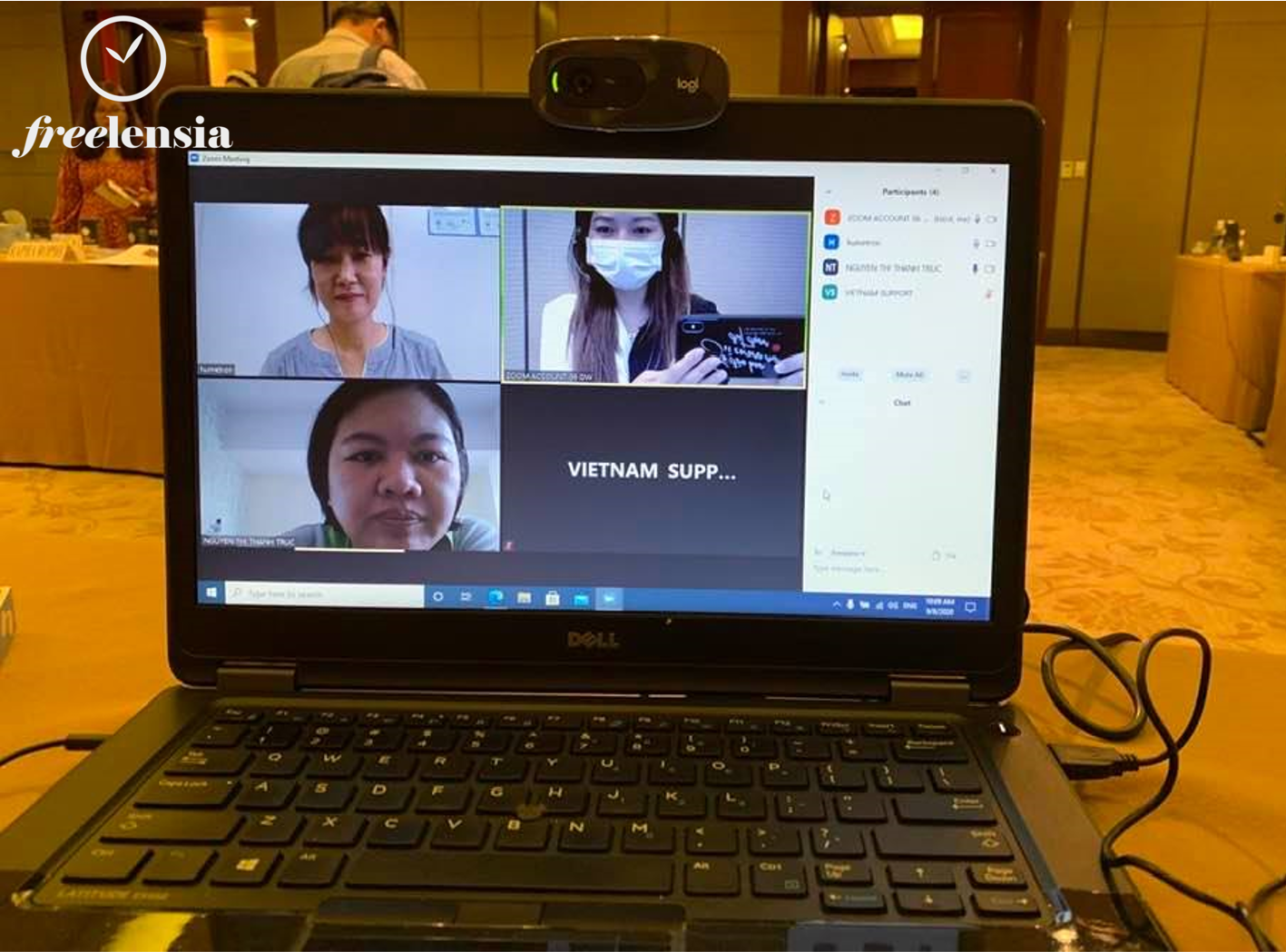
As the coronavirus pandemic continues to disrupt businesses around the world, remote interpretation (aka remote interpreting) has become the preferred method to communicate with foreign business partners via online business meetings, seminars, and conferences. In this article, we will explain what remote interpretation is, its advantages and disadvantages, and the steps required for its execution.
WHAT IS REMOTE INTERPRETATION?
Remote interpretation is interpretation conducted using audio or video-conferencing technology, where some participants are not in the same physical location as each other. Many people use the terms “remote interpretation” (RI) and “remote simultaneous interpretation” (RSI) interchangeably, but in fact, remote interpretation can be performed both simultaneously (aka real time interpretation) or consecutively. Please explore our article in which we explain in details the different modes of interpretation. In this article, we will only focus on remote interpretation in general.

There are three scenarios when it comes to the location of the participants. The interpreter (translator) can sit together with a group of participants while the other participants dial in remotely, the participants can sit together while the interpreter dials in remotely, or the participants and the interpreter can all be located in different places.
ADVANTAGES OF REMOTE INTERPRETATION
1. For clients
-
-
-
- For clients not located in major cities, the level and number of local interpreters are generally low. Remote interpretation allows the client to reach out to higher-quality interpreters or interpreters for rare language pairs.
-
-
- Remote interpretation is useful for short-notice meetings or hospital emergencies, etc. when an interpreter is needed immediately and there is no on-site interpreter. It is also the preferred method to interpret during the COVID-19 pandemic.
- If the event organizers hire interpreters from a different location, they will have to cover the travel and accommodation costs for them. With remote interpretation, there is no need to travel and companies will save a huge sum of money. We have covered this in the article How To Find a Reliable and Affordable Interpreter for a Business Meeting, Exhibition or Seminar?.
- Clients can reach to the interpreters in developing areas to further cut down costs. In addition to the location, other factors also determine the price you pay an interpreter. To find out more, please visit our article How Much Does It Cost To Hire an Interpreter?.
2. For interpreters

- Remote interpretation allows the interpreters to reach out to a larger and more global market. Furthermore, interpreters may be able to quote a higher rate. By the way, a very common question from the interpreters when doing remote interpretation is: What is the suitable rate to offer? Unfortunately, remote interpretation is a fairly new concept so there is no standard rate. But given the same interpretation type, language pair, and pricing unit (daily, half-day, or evening rate), the price will depend on the location of the event or the clients. In particular, clients in developed countries or working for multinational corporations (MNCs) or international organizations have a higher budget yet demand higher interpretation quality and professionalism. You can read more at our How much does it cost to hire an interpreter article.
- Remote interpretation offers more flexible working hours and the possibility of working from home even if the interpreters live in remote areas.
- When the interpreter is not with the participants, it may be easier to concentrate on the interpreting task and not become emotionally affected by the situation being discussed.
- The interpreter may use tools such as dictionaries, Internet searches on his computer while on the job.
DISADVANTAGES OF REMOTE INTERPRETATION
1. The quality of interpretation may be lower
In his book Body Language, Julius Fast showed that when non-verbal and verbal communications conflict, body language can reveal the true meaning of a communication. When it comes to remote interpretation, there is a lack of visual communication components as the interpreter has only a partial view of the speaker and the venue. As such, the interpreter may not understand fully what the speakers want to convey. In the case of audio-only remote interpretation, the interpreter is even more clueless about the speaker’s facial expressions. The lack of eye contact, emotion, and body gestures may also make the presenters repeat themselves because they are not sure whether the listeners are getting the full message.
2. Equipment and software may have issues

Compared to on-site interpretation, remote interpretation requires a more complicated equipment setup, which may lead to higher budget and execution risks. For example, poor internet connection may cause delays or echoes in audio and video quality, while computer crashes and issues with microphones or speakers can abruptly stop the event. One common problem is that the microphone is often fixed in one position, causing poor sound quality from presenters who are sitting far from it. This short and hilarious video below will give you examples of the most common technical issues that can happen in an online meeting.
3. The event’s time may be longer
To make sure the event happens smoothly, the event organizers must spend time to set up and test the equipment before the event starts. For example, they may need to update the latest version of the video conference software before using it.
During the event, more time may be required to reconnect to the Internet, re-setup the microphones, headphones or computers, etc. As mention above, poor connection can cause low sound quality, so the speakers may need to repeat their messages, making the event longer than it should be.
Finally, in a remote interpretation event where speakers do not see each other or just see each other partially, they can miss when a presenter has finished talking and are uncertain about who should be talking next. That will lead to long pauses, interruption, and overlapping talks, which is demonstrated in the same video we showed above. Consequently, more time will be needed to facilitate the turn-taking between the participants.
HOW TO CONDUCT REMOTE INTERPRETATION
1. For clients

To ensure the success of a remote interpretation event, the organizers need to prepare:
- Fast computers and high-quality webcam and microphone.
- When fewer than 5 participants are sitting close to each other, a single webcam and a centrally-placed microphone-speaker device may be used.
- With more participants, it is recommended to set up in front of each participant an external microphone that is connected to a central sound system. Otherwise, each participant should connect to the web-conference software using their own laptop and internal microphone. If a centrally placed microphone-speaker device is used, make sure it has a range large enough so that the farthest person in the room can still be heard.

-
- As previously mentioned, an equipment test must be performed shortly before the event’s start time.
b. A stable and high-speed internet connection
-
- According to this source, you need at least 1 Megabit per second (1 Mbps) of up and down Internet speed for a basic video call. If you want to send or receive 1080p HD-videos, you will need 3 Mbps speed (1 Megabyte or MB is equal to 8 Megabits or Mb).
- A speed and latency test just before the event’s startup time is highly recommended. You can conduct this test at speedtest.net.
c. A video conferencing platform, such as Zoom or Skype, for setting up virtual conference rooms and screen sharing. Please refer to our article for a full list of the most popular free software to use.
-
- For a large number of attendants or long event time, we recommend that clients purchase a paid account to ensure service quality and continuity.
2. For interpreters

Similar to clients, interpreters also need to prepare a computer, a headphone, a microphone, and a good internet connection. Yet there are additional considerations they should take into account:
- The computer must have adequate audio and video hardware for the best possible working conditions. Sometimes, an interpreter may need separate devices for video and audio lines. And they should not use mobile phones!
- As we discussed in the article Interpreting in the Time of the Coronavirus, remote interpreters should find a good workplace with proper lightning and professional background that is clean and in a neutral color. The interpreters should verify the internet speed beforehand, as the internet speed in their homes or cafes may not be adequate for remote interpretation. If the event is important, interpreters can consider hiring a private meeting room by the hour to ensure high Internet speed and quiet surroundings.

- During the interpretation event, the interpreters must make sure there is no distraction by muting their mobile phones and using directional microphones. Wearing appropriate attire is also a must. Please also refer to Interpreting in the Time of the Coronavirus for more on the appropriate etiquettes during a remote interpretation event.
TRY REMOTE INTERPRETATION WITH FREELENSIA!
Freelensia is a platform for clients to easily find remote interpreters in any language pair. From our listings page, you can filter for remote interpreters simply by ticking the “Remote interpretation” checkbox.
For the interpreters, when creating new listings, you can choose to offer either on-site, remote, or both interpretation services by ticking “On-site interpretation” or “Remote interpretation” checkboxes, to let your clients know your offered rates are for which interpretation form.
You are an interpreter looking for a remote interpretation opportunity or a client finding remote interpreters for your upcoming conference? Let Freelensia help you by quickly signing up for a new account at https://www.freelensia.com/signup.
Please visit our home page for more information, or send us an inquiry at support@freelensia.com.
See also
- COVID-19 Multilingual Terminologies
- Why Should You Use a Platform To Reserve Interpreters?
- Different Modes and Types of Interpretation
- Interpreting in the Time of the Coronavirus
- How To Find a Reliable and Affordable Interpreter for a Business Meeting, Exhibition or Seminar?
- How Much Does It Cost To Hire an Interpreter?
- What Is a Highly Paid Language for Interpreters?
